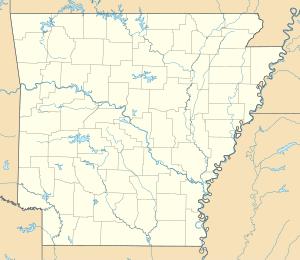Blytheville Air Force Base
| Eaker Air Force Base Blytheville Air Force Base Blytheville Army Airfield  | |
|---|---|
| Part of Strategic Air Command/Tactical Air Command | |
| Blytheville, Arkansas | |
 USGS 2006 airphoto | |
 Eaker AFB | |
| Coordinates | 35°57′52″N 89°56′38″W / 35.96444°N 89.94389°W / 35.96444; -89.94389Coordinates: 35°57′52″N 89°56′38″W / 35.96444°N 89.94389°W / 35.96444; -89.94389 |
| Type | Air Force Base |
| Site information | |
| Controlled by | 461st Bombardment Wing (1956–1958) 97th Bombardment Wing (1959–1991) |
| Site history | |
| Built | 1942 |
| In use | 1942–1946, 1953–1992 |
Blytheville Air Force Base was a United States Air Force base from 1942 until it closed in 1992. It was renamed in 1988 to be Eaker Air Force Base.[1] It was located 3 miles (4.8 km) northwest of Blytheville, Arkansas. The facility is now operated as the Arkansas International Airport.
It was known as Blytheville Army Airfield during 1942–1948, as Blytheville Air Force Base during 1948–1988, and as Eaker Air Force Base during 1988–1992.
Contents
1 Historic district
2 Major commands to which assigned
3 Major units assigned
4 Major aircraft assigned
5 See also
6 References
7 External links
Historic district
Blytheville Air Force Base Strategic Air Command (SAC) Alert and Weapons Storage Areas Historic District | |
U.S. National Register of Historic Places | |
 | |
| Location | 4701 Memorial Drive, Blytheville, Arkansas |
|---|---|
| Coordinates | 35°57′33″N 89°57′47″W / 35.95917°N 89.96306°W / 35.95917; -89.96306 |
| Area | 247 acres (100 ha) |
| NRHP reference # | 100001999[2] |
| Added to NRHP | January 26, 2018 |
The Blytheville Air Force Base Strategic Air Command (SAC) Alert and Weapons Storage Areas Historic District was listed on the National Register of Historic Places in 2018.[2]
It is a 247 acres (100 ha) historic district which included 23 contributing buildings, 33 contributing structures, two contributing sites, and a contributing object, as well as two non-contributing buildings.[3]
Major commands to which assigned

Emblem of the 461st Bombardment Wing, 1956–1958

Emblem of the 97th Bombardment Wing, 1959–1992
Army Air Force Flying Training Command, June 10, 1942 – June 16, 1945- Continental Air Forces, June 16, 1945 – March 21, 1946
- Redesignated Strategic Air Command, March 21, 1946 – April 1, 1946
Tactical Air Command, April 1, 1946 – August 15, 1946, June 10, 1953 – October 1, 1953
Air Materiel Command, October 1, 1953 – July 1, 1954
Tactical Air Command, July 1, 1954 – April 1, 1958
Strategic Air Command, April 1, 1958 – June 1, 1992
Air Combat Command, June 1, 1992 – December 15, 1992 (Not operational)
Major units assigned
- 25th Twin Engine Flying Training Group, July 25, 1942 – February 29, 1944
- Army Air Force Pilot School, May 3, 1942 – May 31, 1945
- 211th Army Air Force Base Unit, May 1, 1944 – June 15, 1945
- 809th Army Air Force Base Unit, June 16, 1945 – March 31, 1946
- 334th Army Air Force Base Unit, April 1, 1946 – November 25, 1946
461st Bombardment Wing, April 8, 1956 – April 1, 1958- 4329th Air Base Squadron, April 1, 1958 – July 1, 1959
97th Bombardment Wing, July 1, 1959 – September 1, 1991
- Redesignated: 97th Wing, September 1, 1991 – April 1, 1992
Major aircraft assigned
North American AT-6, 1942–1944
Curtiss AT-9, 1942–1944- Beech AT-10, 1942–1944
- Republic AT-12, 1942–1944
North American TB-25, 1944
Curtiss C-46, 1945
Douglas C-47, 1945
Martin B-57 Canberra, 1956–1958
Boeing B-52G Stratofortress, 1960–1992
Boeing KC-135A Stratotanker, 1961–1992
See also
- Arkansas World War II Army Airfields
- 30th Flying Training Wing (World War II)
Eaker Site, a major archaeological site within the base's grounds
References
^ "Eaker Air Force Base"..mw-parser-output cite.citation{font-style:inherit}.mw-parser-output .citation q{quotes:"""""""'""'"}.mw-parser-output .citation .cs1-lock-free a{background:url("//upload.wikimedia.org/wikipedia/commons/thumb/6/65/Lock-green.svg/9px-Lock-green.svg.png")no-repeat;background-position:right .1em center}.mw-parser-output .citation .cs1-lock-limited a,.mw-parser-output .citation .cs1-lock-registration a{background:url("//upload.wikimedia.org/wikipedia/commons/thumb/d/d6/Lock-gray-alt-2.svg/9px-Lock-gray-alt-2.svg.png")no-repeat;background-position:right .1em center}.mw-parser-output .citation .cs1-lock-subscription a{background:url("//upload.wikimedia.org/wikipedia/commons/thumb/a/aa/Lock-red-alt-2.svg/9px-Lock-red-alt-2.svg.png")no-repeat;background-position:right .1em center}.mw-parser-output .cs1-subscription,.mw-parser-output .cs1-registration{color:#555}.mw-parser-output .cs1-subscription span,.mw-parser-output .cs1-registration span{border-bottom:1px dotted;cursor:help}.mw-parser-output .cs1-ws-icon a{background:url("//upload.wikimedia.org/wikipedia/commons/thumb/4/4c/Wikisource-logo.svg/12px-Wikisource-logo.svg.png")no-repeat;background-position:right .1em center}.mw-parser-output code.cs1-code{color:inherit;background:inherit;border:inherit;padding:inherit}.mw-parser-output .cs1-hidden-error{display:none;font-size:100%}.mw-parser-output .cs1-visible-error{font-size:100%}.mw-parser-output .cs1-maint{display:none;color:#33aa33;margin-left:0.3em}.mw-parser-output .cs1-subscription,.mw-parser-output .cs1-registration,.mw-parser-output .cs1-format{font-size:95%}.mw-parser-output .cs1-kern-left,.mw-parser-output .cs1-kern-wl-left{padding-left:0.2em}.mw-parser-output .cs1-kern-right,.mw-parser-output .cs1-kern-wl-right{padding-right:0.2em}
^ ab "National Register of Historic Places: Weekly list". National Park Service. January 26, 2018.
^ Edward Salo; Edward Harthorn; Zach Mitchell; Frank Walker; Travis Raterman (September 11, 2017). "National Register of Historic Places Registration: Blytheville Air Force Base Strategic Air Command (SAC) Alert and Weapons Storage Areas Historic District" (PDF). National Park Service. Retrieved February 19, 2018. With maps and 23 photos.
External links
| Wikimedia Commons has media related to Blytheville Army Airfield. |
| Wikimedia Commons has media related to Eaker Air Force Base. |
- Arkansas Aeroplex
- Abandoned & Little Known Airfields
- Biography of Ira C. Eaker
- Arkansas Northeastern College (formerly Mississippi County CC)
This article about a property in Arkansas on the National Register of Historic Places is a stub. You can help Wikipedia by expanding it. |


